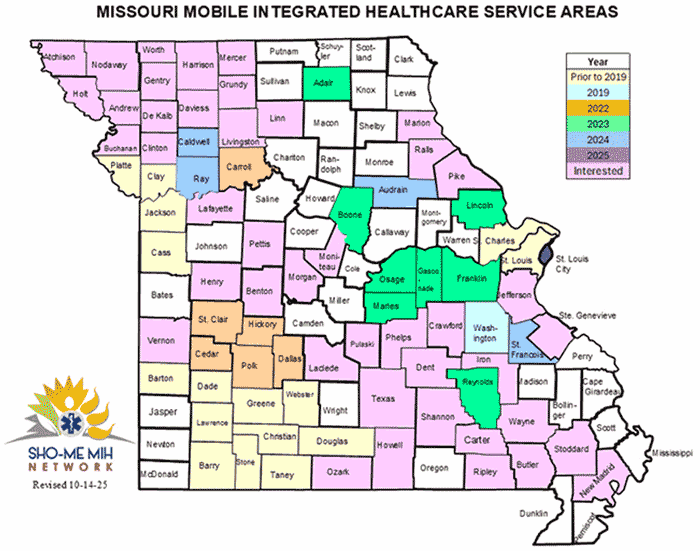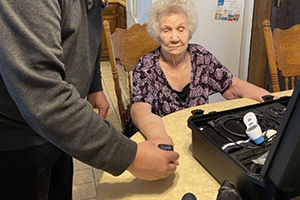Mobile Integrated Healthcare Network (MIHN)
- Need: To bring preventive care and other services to rural Missouri patients with chronic illnesses and difficulties accessing primary care.
- Intervention: Community paramedics make home visits and provide basic care, home assessments, and medication reconciliation and facilitate telehealth visits.
- Results: Patients experienced improved access to care, health status, and compliance with medication regimens along with increased patient engagement, satisfaction, and access to community resources.
Description
The Mobile Integrated Healthcare Network® (MIHN), also called SHO-ME MIH Network, in Missouri has community paramedics (CPs) make regular home visits to patients who are chronically ill, at high risk of medical emergencies, and lacking access to primary care. In addition, patients who were recently in the hospital, have trouble managing their conditions, and/or were referred by a provider are eligible for the program. Community health workers (CHWs) schedule appointments for the CP visits, conduct assessments to address social needs, and identify and link individuals to resources to meet identified needs.
SHO-ME MIH Network began as a pilot project in Washington County serving patients with diabetes; the Washington County Ambulance District partners with the Great Mines Health Center (a Federally Qualified Health Center, or FQHC), Community Asset Builders, and Mineral Area College. When the project succeeded, it expanded to reach patients with other conditions and to more counties and in August 2022 received a 501(c)(3) designation. The program has also offered COVID-19 testing, vaccinations, and monthly food bank deliveries to patients. Most recently, the program has expanded to provide substance use and opioid use disorder services, including field initiation of suboxone.
Local MIH Networks are currently serving 28 rural counties in Missouri. The program is being replicated in Norwich as well as Dickinson and Ottawa counties in Kansas. Six of the counties (three in Missouri and three in Kansas) received private foundation funding in September 2024 to replicate the SHO-ME MIH Network model.

SHO-ME MIH Network partners with the Missouri Department of Health and Senior Services, including the Office of Rural Health and Primary Care as well as the Bureau of Cancer and Chronic Disease Control. The program also collaborates closely with the Missouri EMS Association to provide MIH technical assistance, education, and training for new and existing MIH Networks.
The MIHN pilot project in Washington County received funding from the Federal Office of Rural Health Policy (FORHP) Rural Health Care Services Outreach grant program and has secured other federal and state funding to support model expansion and replication.
Services offered
CHWs coordinate visits, assess for social determinants of health, and identify resources to meet patients' needs. They connect CPs to patients through scheduled home visits, in which CPs offer the following care:
- Basic preventive care, including detailed assessments, vital signs, lab draws, EKGs, ultrasounds, wound care, and IV infusions
- Home safety assessments
- Medication reconciliation
- Facilitation of telehealth visits with providers
- Assessing and addressing social determinants of health
- Care coordination, primary care provider enrollment, and Medicaid navigation

Patients can self-refer to the program or be referred by a healthcare provider, emergency medical services (EMS) provider, or hospital emergency department upon discharge.
Results
In the Washington County pilot project's first year, it served 21 patients and recorded a 100% decrease in emergency transport for all participants. This county's MIHN made 7,000 encounters in 2021 and 8,000 encounters in 2022. Learn more about the Washington County pilot project in the Rural Monitor article Breaking the Cycle: Missouri Community Paramedicine Program Brings Primary Care to High-Risk Patients.
To date, SHO-ME MIH Network, which now serves the counties of Washington, Reynolds, and a portion of Dent, has 650 individuals enrolled.
In the larger program, patients also experienced improved access to care, health status, and compliance with medication regimens along with increased patient engagement, satisfaction, and access to community resources, all while reducing the cost of short-term and projected long-term care.
SHO-ME MIH Network compared cost data pre- and post-MIH enrollment, which demonstrates there are actual savings and cost avoidance savings attributable to the MIH interventions. The cost savings occur primarily for payers and the MIH Network partners providing the needed healthcare services, including the hospitals, FQHCs, and EMS agencies.
MIHN is featured in our Chronic Disease Management Toolkit Program Clearinghouse.
Challenges
Some patients struggled to connect to the internet for telehealth visits, so program coordinators added a mobile hotspot to the MIHN vehicle. The vehicle also has refrigerators to carry blood and urine samples.
Some patients need more or different types of support to change utilization behaviors. When patients do not comply with recommended treatment or care, they are linked back to a behavioral health provider to determine if behavioral health services are needed in addition to primary care.
The demand for services grew very rapidly, which created workforce gaps. These workforce gaps were addressed by building a local pipeline of emergency medical technicians (EMTs), CHWs, paramedics, and CPs through a community college. Resources were leveraged from other grants, local workforce boards, and regional partners, in addition to the scholarships offered by the project to assist paramedics in receiving a CP endorsement on their paramedic license.
Funding is a challenge. At the beginning, Medicaid in Missouri did not reimburse CP services, but now Missouri's Medicaid managed care organizations are reimbursing for CP services under the MIH model through "in lieu of service" (ILOS) agreements.
Data collection and monitoring was by far the biggest challenge. Most recently, the Network has entered into an agreement with a data platform that can capture and track both EMS and healthcare data. Reports and dashboards can also be generated from the platform in real time.
Replication
The Network documented processes and workflows to aid other communities with replicating this project and had readily available tools and technical assistance so that other networks have the resources and confidence to be successful.
Build trust with patients. Take the time to talk with them and answer their questions.
All CPs and EMTs in the program are certified as CHWs. Mineral Area College allows students to earn a paramedic certification and a CHW certification at the same time.

Contact Information
Justin Duncan, CEOWashington County Ambulance District
jduncan@wcadems.org
Topics
Community health workers
· Community paramedicine
· Emergency medical technicians and paramedics
· Federally Qualified Health Centers
· Home health
· Telehealth
States served
Kansas, Missouri
Date added
September 12, 2023
Suggested citation: Rural Health Information Hub, 2025 . Mobile Integrated Healthcare Network (MIHN) [online]. Rural Health Information Hub. Available at: https://www.ruralhealthinfo.org/project-examples/1119 [Accessed 14 December 2025]
Please contact the models and innovations contact directly for the most complete and current information about this program. Summaries of models and innovations are provided by RHIhub for your convenience. The programs described are not endorsed by RHIhub or by the Federal Office of Rural Health Policy. Each rural community should consider whether a particular project or approach is a good match for their community’s needs and capacity. While it is sometimes possible to adapt program components to match your resources, keep in mind that changes to the program design may impact results.
